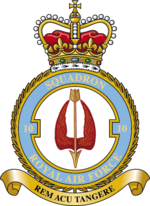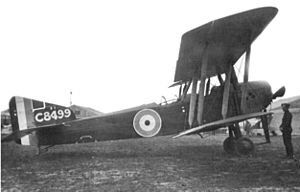No. 10 Squadron RAF facts for kids
Quick facts for kids No. 10 Squadron RAF |
|
|---|---|

Squadron badge
|
|
| Active | 1 January 1915 – 1 April 1918 (RFC) 1 April 1918 – 31 December 1919 (RAF) 3 January 1928 – 20 December 1947 4 October 1948 – 20 February 1950 15 January 1953 – 15 January 1957 15 April 1958 – 1 March 1964 1 July 1966 – 14 October 2005 1 July 2011 – present |
| Country | |
| Branch | |
| Type | Flying squadron |
| Role | Air transport and air-to-air refuelling |
| Part of | No. 2 Group |
| Home station | RAF Brize Norton |
| Nickname(s) | 'Shiny Ten' |
| Motto(s) | Rem acu tangere (Latin for 'To hit the mark') |
| Aircraft | Airbus Voyager KC2/KC3 |
| Battle honours |
|
| Insignia | |
| Squadron badge | Featuring a winged arrow, the squadron badge was designed by Wing Commander Whitelock while watching archery practice in Oxford. He thought the bomb was the modern equivalent of the medieval arrow, and the wings were added to indicate great speed. Approved by King George VI in September 1937. |
| Squadron codes | PB (Nov 1938 – Sep 1939) ZA (Sep 1939 – Aug 1945; 1948 – 1950) |
No. 10 Squadron is a special flying unit of the Royal Air Force (RAF). Over its long history, which spans more than 90 years, it has done many different jobs. These include watching from the sky, dropping bombs, carrying supplies, and even refuelling other planes in the air. Today, the squadron flies the Airbus Voyager KC2/KC3 aircraft. It uses these planes for transport and air-to-air refuelling from its base at RAF Brize Norton in Oxfordshire, UK.
History of No. 10 Squadron
Early Days: First World War
No. 10 Squadron started on 1 January 1915 as part of the Royal Flying Corps. It began as a training unit at Farnborough Airfield. In July 1915, the squadron moved to France to join the Western Front.
The squadron's first big job was helping the Indian Corps during the Battle of Loos in September 1915. They used Royal Aircraft Factory B.E.2 planes to spot for ground troops. They also took part in the Battle of the Somme in 1916. In April 1917, No. 10 Squadron helped with spotting and bombing during the Second Battle of Arras. They later got new planes, the Armstrong Whitworth F.K.8, in September 1917.
In June 1918, the squadron started using the Bristol F.2b. They fought in the Second Battle of the Somme in August and September 1918. After the war ended, the squadron briefly stayed in Germany as part of the army. No. 10 Squadron was officially closed down on 31 December 1919. This happened to many squadrons after the First World War.
Between the World Wars
No. 10 Squadron was started again on 3 January 1928. This time, it was a night bomber unit based at RAF Upper Heyford. They flew Handley Page Hyderabad planes. In April 1931, the unit moved to RAF Boscombe Down and got new Handley Page Hinaidi aircraft.
These planes were soon replaced by Vickers Virginia aircraft in September 1932. Then, in 1934, they received the Handley Page Heyford. The squadron also helped create other new squadrons, like No. 97 Squadron and No. 78 Squadron. In January 1937, No. 10 Squadron moved to RAF Dishforth. Here, they became part of the new No. 4 Group of RAF Bomber Command. They also started flying the Armstrong Whitworth Whitley Mk.I monoplane.
No. 10 Squadron in the Second World War
The squadron's first mission in the Second World War was on 8 September 1939. They flew a leaflet dropping mission over Germany using their Whitley Mk.IV planes. On the night of 11/12 June 1940, Whitleys from No. 10 Squadron attacked the Italian cities of Turin and Genoa.
On 8 July 1940, the unit moved to RAF Leeming in Yorkshire. Later, on 23 September 1940, the squadron attacked the Boulogne docks in France, which was occupied by enemy forces.
In December 1941, the squadron switched to flying the Handley Page Halifax Mk.I/Mk.II. In July 1942, part of the squadron went to RAF Aqir in the British Mandate. This group later formed No. 462 Squadron for the Royal Australian Air Force. On 19 August 1942, No. 10 Squadron moved to RAF Melbourne, Yorkshire. They stayed there until the war in Europe ended.
On 7 May 1945, No. 10 Squadron joined RAF Transport Command. They began flying Douglas Dakota transport planes. The squadron moved to RAF Broadwell in Oxfordshire on 6 August 1945.
After the Wars: Post-War Operations
Transport and Airlift (1945–1950)
After the war, No. 10 Squadron moved to India in October 1945. They continued transport duties until they were disbanded on 20 December 1947. The squadron was reformed on 4 October 1948. This happened when No. 238 Squadron was renamed No. 10 Squadron at RAF Oakington.
Between 1948 and 1949, the squadron played a key role in the Berlin Airlift. They flew supplies into Berlin from RAF Lübeck. No. 10 Squadron was disbanded again on 20 February 1950.
Bomber Missions (1953–1964)
On 15 January 1953, No. 10 Squadron went back to its original role as a bomber unit. They reformed at RAF Scampton and flew the English Electric Canberra B.2. In April 1955, the squadron moved to RAF Honington.
From October to November 1956, No. 10 Squadron was sent to RAF Nicosia in Cyprus during the Suez Crisis. A Canberra B.2 plane from No. 10 Squadron dropped the first RAF bombs on Egypt. This happened during a raid on Almaza Air Base on 31 October 1956. The squadron was disbanded on 15 January 1957.
No. 10 Squadron reformed again at RAF Cottesmore on 15 April 1958. They flew the Handley Page Victor B.1 until they were disbanded on 1 March 1964.
The Vickers VC10 Era (1966–2005)
In 1965, the squadron's role changed from bombing to transport. On 1 July 1966, the squadron reformed at RAF Brize Norton. They were the first to use the new Vickers VC10 C.1 aircraft.
Fourteen VC10 C.1 planes were given to No. 10 Squadron between 1966 and 1967. These planes were special versions of the civil 'Standard VC10'. They had stronger wings and more powerful engines. The C.1 could carry 139 passengers or a lot of cargo. These VC10s were named after airmen who had won the Victoria Cross.
No. 10 Squadron's VC10s were often used to fly important people, like the British Royal Family and government leaders, around the world. They also helped with medical evacuations. Later, other planes took over the VIP transport role. However, former Prime Minister Tony Blair still used the VC10 for very important flights. This included trips to Pakistan and the Middle East after the 11 September 2001 attacks. No. 10 Squadron was disbanded on 14 October 2005. Their C.1(K) aircraft were moved to No. 101 Squadron.
Modern Day: Airbus Voyager (2011–present)

In 2011, No. 10 Squadron was reformed to be the first to operate the new Airbus Voyager aircraft. The squadron officially started again on 1 July 2011. The first Voyager plane arrived at Brize Norton on 5 April 2012.
The squadron began flying the Voyager on 12 May 2012. Their first flight was from RAF Brize Norton to RAF Akrotiri in Cyprus. The first time they refuelled another plane in the air was on 20 May 2013. No. 10 Squadron refuelled Panavia Tornado GR4 planes. Since September 2014, No. 10 Squadron has helped support Operation Shader, which is a military operation.
Aircraft Operated by No. 10 Squadron
Here is a list of the different aircraft types that No. 10 Squadron has flown throughout its history:
- Farman MF.7 (Jan 1915 – Apr 1915)
- Farman MF.6 (Jan 1915 – Apr 1915)
- Blériot XI (Jan 1915 – Apr 1915)
- Martinsyde S.1 (Jan 1915 – Apr 1915)
- Royal Aircraft Factory B.E.2c (Jan 1915 – Apr 1917)
- Royal Aircraft Factory B.E.12 (June 1916 – July 1916)
- Royal Aircraft Factory B.E.2d (July 1916 – Feb 1917)
- Royal Aircraft Factory B.E.2e (Dec 1916 – July 1917)
- Royal Aircraft Factory B.E.2f (Jan 1917 – July 1917)
- Royal Aircraft Factory B.E.2g (Jan 1917 – July 1917)
- Armstrong Whitworth F.K.8 (July 1917 – Feb 1919)
- Bristol F.2b (June 1918 – Oct 1918)
- Handley Page Hyderabad (Jan 1928 – Nov 1931)
- Handley Page Hinaidi (Dec 1930 – Sep 1932)
- Vickers Virginia Mk.X (Sep 1932 – Jan 1935)
- Handley Page Heyford Mk.Ia (Aug 1934 – Jan 1936)
- Handley Page Heyford Mk.III (Nov 1935 – Jun 1937)
- Armstrong Whitworth Whitley Mk.I (Mar 1937 – June 1939)
- Armstrong Whitworth Whitley Mk.IV (May 1939 – May 1940)
- Armstrong Whitworth Whitley Mk.V (May 1940 – Dec 1941)
- Handley Page Halifax Mk.I (Dec 1941 – Aug 1942)
- Handley Page Halifax Mk.II (Dec 1941 – Mar 1944)
- Handley Page Halifax Mk.III (Mar 1944 – May 1945)
- Douglas Dakota Mk.III (May 1945 – Dec 1947)
- Douglas Dakota Mk.IV/C.4 (May 1945–Dec 1947; Oct 1948 – Feb 1950)
- English Electric Canberra B.2 (Jan 1953 – Dec 1956)
- Handley Page Victor B.1 (Apr 1958 – Mar 1964)
- Vickers VC10 C.1 (July 1966 – Nov 1995)
- Vickers VC10 C.1K (Dec 1992 – Oct 2005)
- Airbus Voyager KC.2 (Apr 2012 – present)
- Airbus Voyager KC.3 (Sep 2013 – present)
See also
- List of Royal Air Force aircraft squadrons




